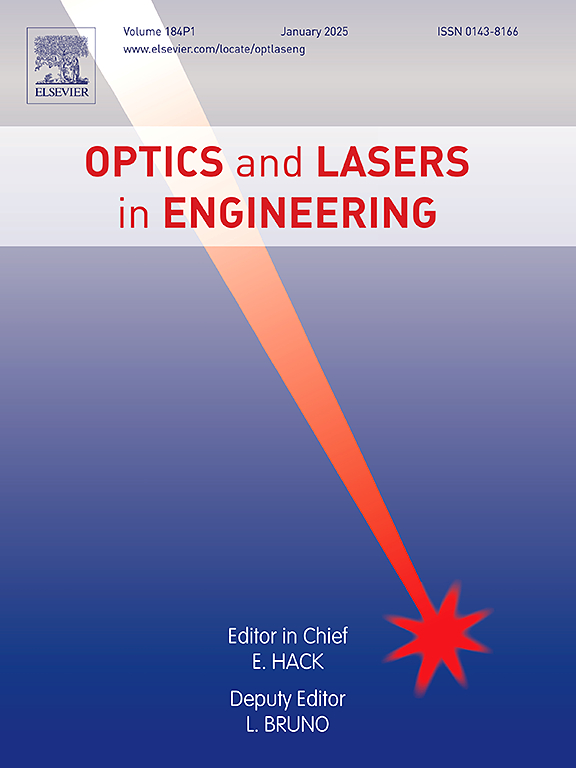用光纤光栅测量直升机旋翼襟翼的飞行应变
IF 3.5
2区 工程技术
Q2 OPTICS
引用次数: 0
摘要
由于布线复杂、易受电磁干扰和可靠性问题,传统的电应变片在转子叶片应用中面临限制。本研究提出了一种基于光纤布拉格光栅(FBG)的飞行应变测量系统,该系统通过利用FBG传感器的紧凑性、电磁抗扰性和适合FBG传感器的分布式测量来克服这些挑战。一个关键的创新是将系统直接集成到转子轮毂中,没有滑环或光学连接器,这大大简化了部署,增强了鲁棒性。在等强度梁上与电应变计和理论模型进行对比验证,证实了FBG测量的准确性。在一架直升机上进行的地面和飞行测试表明,在叶片弹性变形过程中,FBG数据与常规测量结果非常接近,可以实时、无干扰地测量应变。关键的是,该系统的安装不会影响直升机的性能,正如飞行员评估所证实的那样。此外,分析不同飞行条件下的叶片襟翼应变趋势,为叶片设计优化提供了有价值的见解。这项工作通过为复杂的电磁环境建立可靠、轻量级的解决方案来推进转子叶片监测,解决了现有应变测量方法中的关键空白。本文章由计算机程序翻译,如有差异,请以英文原文为准。
Flight strain measurement of helicopter rotor blade flaps using fiber grating
Traditional electrical strain gauges face limitations in rotor blade applications due to complex wiring, susceptibility to electromagnetic interference susceptibility, and reliability issues. This study presents a Fiber Bragg Grating (FBG) based in-flight strain measurement system that overcomes these challenges by leveraging the FBG sensors' compactness, electromagnetic immunity, and suitability for distributed measurements of FBG sensors. A key innovation is the direct integration of the system into the rotor hub without slip rings or optical connectors, which significantly simplifying simplifies deployment and enhancing enhances robustness. Comparative validation against electrical strain gauges and theoretical models on an equal-strength beam confirmed the accuracy of FBG measurements. Ground and flight tests on a helicopter demonstrated real-time, interference-free strain measuring during blade elastic deformation, with FBG data closely aligning closely with conventional gauge results. Critically, the system’s installation did not affect helicopter performance, as confirmed by pilot evaluations. Furthermore, analysis of blade flap strain trends under diverse flight conditions provides valuable insights for blade design optimization. This work advances rotor blade monitoring by establishing a reliable, lightweight solution for complex electromagnetic environments, addressing critical gaps in existing strain measurement methodologies.
求助全文
通过发布文献求助,成功后即可免费获取论文全文。
去求助
来源期刊

Optics and Lasers in Engineering
工程技术-光学
CiteScore
8.90
自引率
8.70%
发文量
384
审稿时长
42 days
期刊介绍:
Optics and Lasers in Engineering aims at providing an international forum for the interchange of information on the development of optical techniques and laser technology in engineering. Emphasis is placed on contributions targeted at the practical use of methods and devices, the development and enhancement of solutions and new theoretical concepts for experimental methods.
Optics and Lasers in Engineering reflects the main areas in which optical methods are being used and developed for an engineering environment. Manuscripts should offer clear evidence of novelty and significance. Papers focusing on parameter optimization or computational issues are not suitable. Similarly, papers focussed on an application rather than the optical method fall outside the journal''s scope. The scope of the journal is defined to include the following:
-Optical Metrology-
Optical Methods for 3D visualization and virtual engineering-
Optical Techniques for Microsystems-
Imaging, Microscopy and Adaptive Optics-
Computational Imaging-
Laser methods in manufacturing-
Integrated optical and photonic sensors-
Optics and Photonics in Life Science-
Hyperspectral and spectroscopic methods-
Infrared and Terahertz techniques
 求助内容:
求助内容: 应助结果提醒方式:
应助结果提醒方式:


